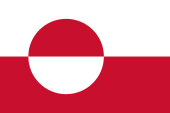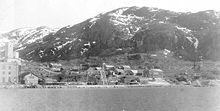Postal history and postage stamps from Greenland
The postal history of Greenland is closely based on the story of the former motherland Denmark connected. Due to its remote location and size, however, an almost independent postal system has developed over time. For more information on the general history of Greenland, see the article Greenland .
Greenland under Danish rule
The beginnings of the Greenland postal service
After Hans Egede, the first Europeans to settle Greenland in 1721, the Greenland postal system was built up very slowly and slowly. On the largest island in the world, the establishment of post offices and postal connections made little progress, mainly due to the difficult climatic conditions and the low population. In 1774 the state-controlled Den Kongelige Grønlanske Handel (KGH) finally received the monopoly for postal traffic. Denmark thus controlled the establishment of the postal system even before the Peace of Kiel on January 14, 1814. In this peace treaty, Denmark was finally awarded the island.
In addition to the difficulties of setting up a postal system on the island itself, the polar climate of the KGH also made it almost impossible to deliver international mail to Greenland with the help of ship mail . Only one boat trip to Denmark could be carried out annually in the summer months. In the second half, this postal service was slowly expanded. Since 1888, mostly steamers, until then sailing ships, were used. By 1900, however, there were still only two to five mail voyages a year.
The post of the cryolite mines
The small town of Ivittuut in the southwest of the island occupies a special position in the early development of the Greenland postal system . Cryolite (ice stone ) has been mined in it since 1865 . The rare and valuable mineral has only been found at this point worldwide. The mining company made ship connections to Denmark much more frequent than in the rest of Greenland. They agreed to carry mail along with their journeys and thus ensured excellent postal services for the small town compared to the rest of the country.
The Pakke postage issues
In 1905 it was finally decided to unify the postal system. The transport of parcels in Greenland and especially the international parcel transport to and from was uniformly regulated. For this purpose, three different parcel postage stamps of 1, 5 and 10 Øre were issued. The stamps were made in Denmark and all show the Greenland coat of arms, the standing polar bear, as the central motif. The circulation of the so-called “Pakke-Porto” stamps was between 5,000 and 10,000. This is comparatively high when measured against the population of Greenland at the time, at 10,000.
In addition to parcel traffic, mail was also regulated in a uniform manner. This was carried out free of charge in the whole of Greenland, as was customary up to then, regardless of the size of the letter. This special privilege remained with the Greenlanders until May 1959. However, no stamps were issued by the Greenland Post for possible international letters. These were transported as parcels with the help of the parcel postage stamps.
This Greenland postal system remained almost unchanged for the next thirty years. The series of three parcel postage stamps has been expanded to nine different values over the years. Finally, in 1937, both the inscription on the stamps and the polar bear got a little thicker. The increased number of copies, with a value of 20 Øre, 344,000 pieces were produced, but testify to the increased mail volume in the country. At that time, up to 17 different ships were on the move with mail transports in the summer months.
The post office in Avanersuaq
Avanersuaq is the northernmost area of Greenland. The northernmost settlements in the world can be found in it. It was quite difficult for the Greenland Post to supply this area by post. That is why there was a request from Qaanaaq , the largest town in Avanersuaq, whether they could set up their own postal connection by ship to Copenhagen. The Greenland Post allowed this and also allowed the issuance of its own postage stamps to frank the letters carried by ship. On July 16, 1935, such stamps were finally issued. They were created in Copenhagen on a private initiative. It is therefore the first postage stamp to be used in Greenland. This four-part series of stamps was issued in the anniversary year of 1935 under the motto "25 years of founding the Qaanaaq settlement". The stamps, however, bore the inscription Thule / 1910–1935. Thule was the Danish name for the settlement. The values of 10, 15, 30 and 45 Øre showed walruses and the Danish flag, Knud Rasmussen , the founder of the settlement and Cape York. In 1936, a further supplementary value of 25 Øre with a picture of the settlement was issued, but the private shipping connection to Copenhagen was discontinued on July 31, 1937.
The takeover by the Royal Danish Post
On December 1, 1938, the entire postal service in Greenland was taken over by the Royal Danish Post. This entailed the abolition of parcel postage stamps and the introduction of common postage stamps throughout Greenland. Unlike in the Faroe Islands or Iceland, the Danish Post took this step very late. The postage stamp series of 1, 5, 7, 10, 15 and 30 Öre as well as a crown showed the portrait of the Danish King Christian X. and the two highest values a polar bear.
Due to the occupation of Denmark by the German Empire, this edition remained the only one for a long time. Eventually all connection with the motherland was lost and Greenland turned to the USA and Canada. The US Army came to the island itself and set up several airports for military tactical reasons, which were also used for the first airmail connections from 1941 onwards. In 1945, the country finally turned to the United States for help in making postage stamps.
Soon after Greenland's request, 70,000 sets of new Greenlandic postage stamps were issued by the American Bank Note Co. in New York. This series, often referred to as the American Issue , consisted of nine values, which, in addition to the Danish King Christian X, also showed seals, Inuit kayaks, dog sleds and polar bears. After the liberation of Denmark, the American Issue was labeled Danmark / Befriet / May 5, 1945 . After the Americans withdrew in 1946, Greenland airmail was discontinued.
However, the Danish Post quickly took over the Greenlandic postal system and soon reintroduced its own stamp issues. An air mail network with the connection to Denmark was also set up in 1949. Finally, the first special stamps and charity stamps were issued at the end of the 1950s.






